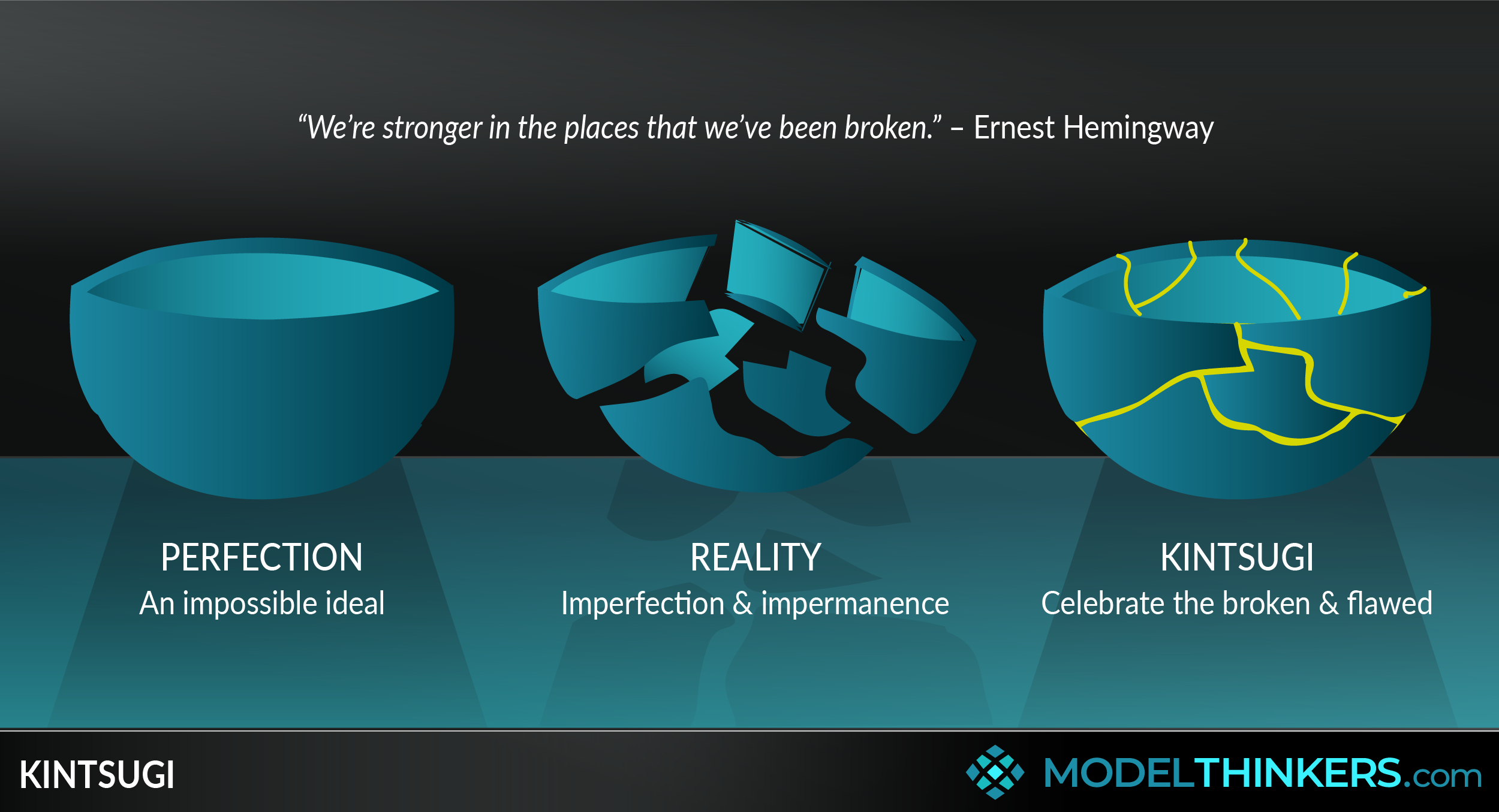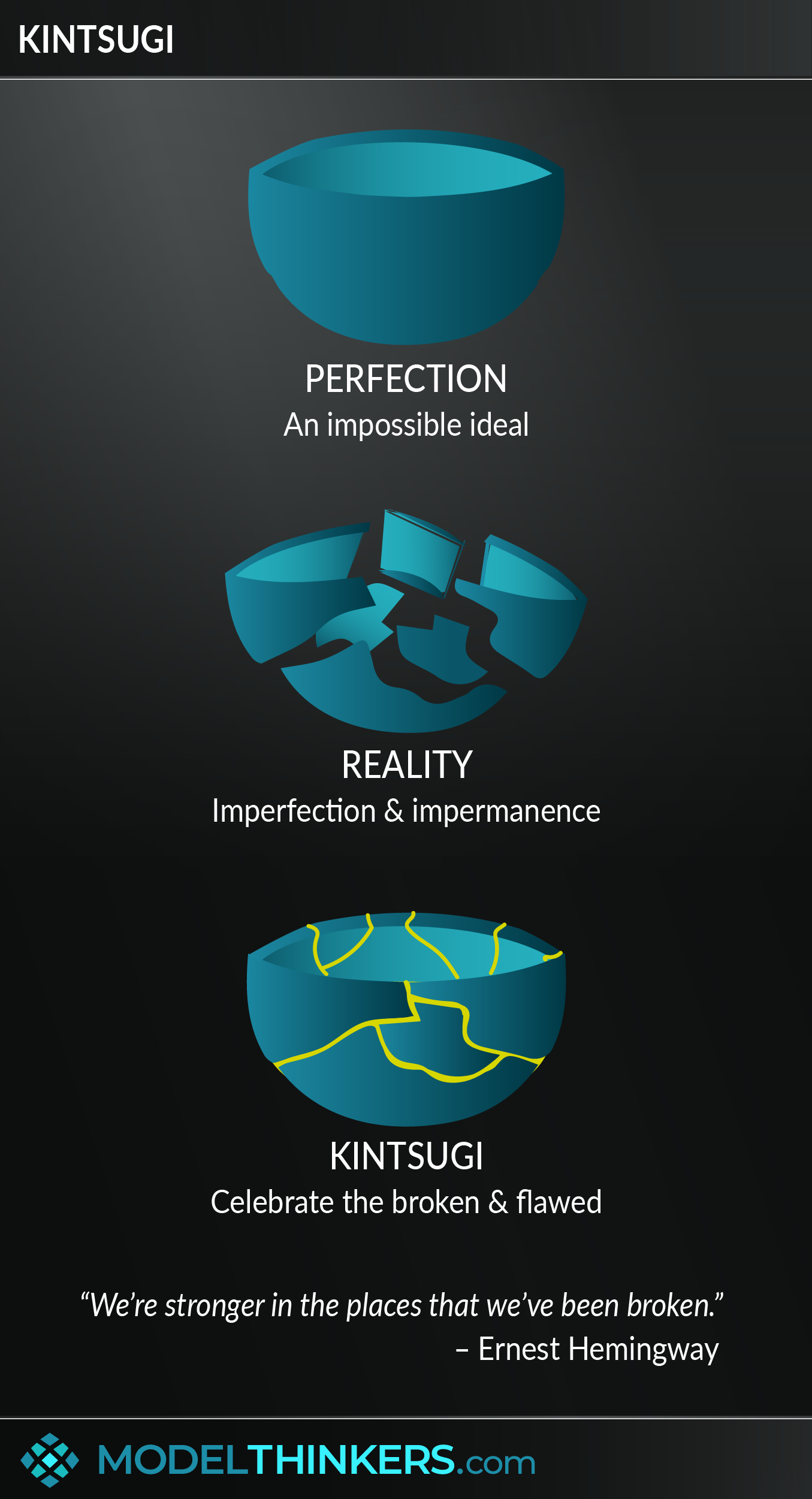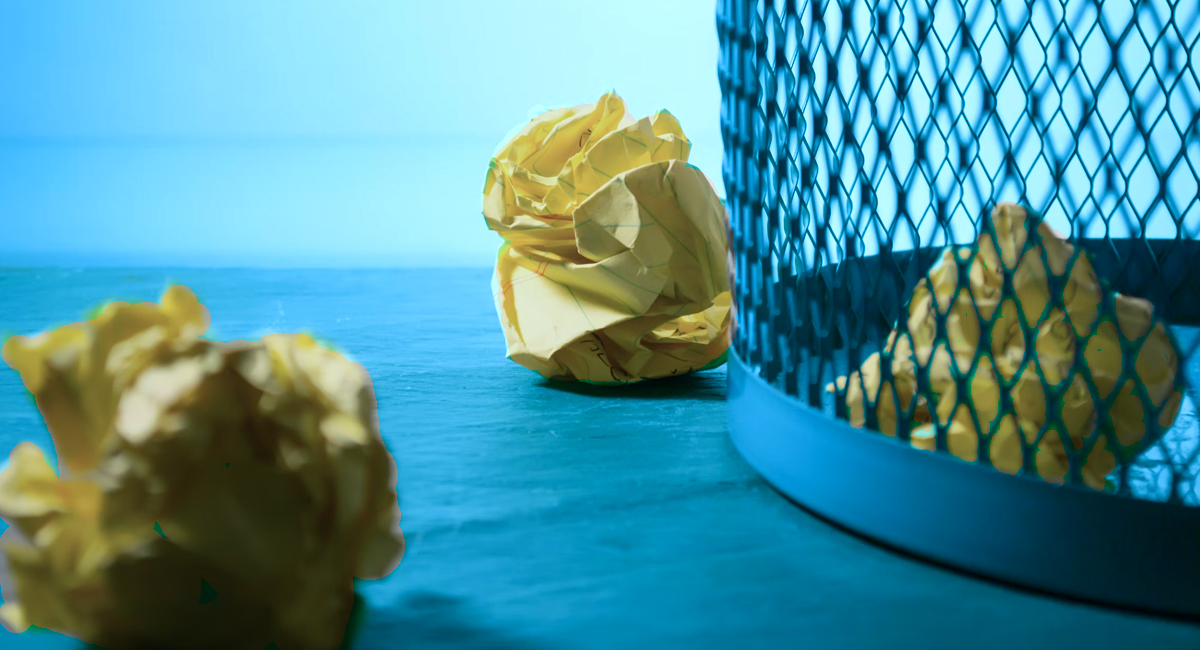

 0 saved
0 saved
 29.2K views
29.2K views








“Never be ashamed about being broken, because strength is nothing but pain that's been repaired.” - Trent Sheldon.
Kintsugi is the Japanese art of repairing broken pottery with gold lacquer to enhance rather than hide the breaks. It embodies a philosophy of embracing imperfections, breakages, and ‘scars’ as celebrated parts of the new.
EMBRACE IMPERMANENCE AND IMPERFECTION.
The simple beauty of Kintsugi is a reflection of wabi-sabi, which was described in Richard Powell’s book Wabi-Sabi Simple as embracing that “Nothing lasts, nothing is finished, and nothing is perfect.” In that sense, applying Kintsugi involves shifting from being frustrated about an unattainable perfection, to embracing gratitude for the imperfect and impermanent.
FORGE YOURSELF WITH CYCLES OF RUPTURE AND REPAIR.
Kintsugi prompts us to reconsider and even celebrate the broken and repaired. As British Journalist Chris Cleave reminds us, “A scar does not form on the dying. A scar means, ‘I survived.’" Persian poet Rumi took that idea further, seeing scars as potentials for growth or, as he described it, “The wound is the place where the light enters you.”
Importantly, cycles of rupture and repair move away from the original and create something new, something different, and perhaps something that you can value.
GETTING PRACTICAL.
How do you apply Kintsugi? Sure, you can start repairing broken crockery with gold lacquer however, if you want to take it further, you can use the concept behind it as a reminder to celebrate the damaged, the broken, and the repaired in countless contexts. For example:
-
Reject consumerist and disposable trends. Rather than throwing something at the first sign of imperfection or breakage, how can you embrace and even highlight it as part of the ‘story of that object’. In doing so, consider what you will create that is new and unique.
-
Reframe failure. When working on a project that goes terribly wrong, reframe that break as an essential part of your project’s story. Rather than covering it up, consider how you will speak to it and build from it.
-
Find compassion for yourself as you acknowledge your big struggles. We’ve all had rough times, breaks, ruptures and even collapses. Rather than pretend that they didn’t happen, consider how you might wear those scars and repairs with pride. After all, they are part of what has forged the person you’ve become today.
-
Accept imperfection and impermanence in people around you. Once you’ve found compassion for yourself, explore how you might find it for those around you. Know that everyone will struggle and that their challenges can help to define, and even reinvent themselves.
IN YOUR LATTICEWORK.
The impermanence of Kintsugi, born from Zen philosophy, has interesting alignment with Entropy, the Second Law of Thermodynamics. The idea of reinvention from the old might be compared to the economic model of Creative Destruction, though the latter describes the destruction of the old rather than the repair or addition to it.
Some of the mindset shifts around failure that Kintsugi encourages can be supplemented with Return on Failure, and even First Principles to identify the core of what’s important. If you’re trying to maintain a positive and resilient outlook in our impermanent world, you might also want to combine this approach with the Stockdale Paradox. Finally, the value of repairing rather than replacing something might also be understood in the context of the Ikea Effect.




-
Embrace imperfection and impermanence.
Let go of trying to reach an unattainable perfection, and accept that nothing lasts forever. Practice shifting your focus on appreciating the broken, the damaged, and the scarred as part of life's journey.
-
Value and celebrate repair.
Shift from hiding the healing, and find ways to celebrate scars and repairs as essential parts of what has been created. It’s accepting that cycles of rupture and repair will always create something new.
-
Stop trying to 'return to normal' and 'embrace the new normal'.
Kintsugi is a reminder to embrace impermanence and the inability to go back to where things were. Instead, embrace the repair and the new that has resulted from the journey.
At a basic level, Kintsugi is simply about repairing crockery.
The philosophy behind it, particularly wabi-sabi, has been simplified for the purposes of our summary and as such will likely lose much of what followers and practitioners practice and believe. As such, the main criticism that we can cite here is that the philosophy might feel too abstract to some and too superficial to others. That said, we felt that a summary of Kintsugi might still be a useful and potentially disruptive way of shifting the way you view yourself, people, projects and even life.
The traditional Kintsugi.
Here is an example of what Kintsugi looks like when applied as a practice to repairing crockery.
From Lakeside Pottery.
The Kintsugi of Covid
It was inevitable that people would use Kintsugi to help make sense of Covid. This Forbes article is one of several that encourage a shift of mindset to let go of our old way of working and living, and embracing the ‘new’ that has come through our Covid experience that truly broke the world in many ways.
The Kintsugi of Grief.
This article in the Guardian newspaper describes a personal journey of the author in using Kintsugi to come to terms with her brother's death. She writes:
“If we recognise that we are all imperfect, a metaphoric repair could include acts of forgiveness, affection, validation, acceptance, or simply a warm embrace. Apology can be a particularly potent repair material.
"I think back to the eight-year-old I was and the years that followed the tragedy of my brother’s death, and I now acknowledge that although that loss did leave scars, it also made me stronger and better. My brother has been the kintsugi project that has made me who I am.”
f
Kintsugi is a compound of two Japanese words, ‘Kin’ meaning ‘golden’ and ‘tsugi’ meaning ‘joinery’.
It’s origins are unclear, though a dominant narrative tells of 15th-century Japanese shogun Ashikaga Yoshimasa sending a damaged Chinese tea bowl back to China for repairs. The initial repair was supposedly done with ugly metal staples which led others to seek out more effective approaches, including the golden lacquer.
When it was returned, repaired with ugly metal staples, the bowl may have prompted Japanese craftsmen to look for a more aesthetic means of repair. Collectors became so influenced with the new art that some were accused of deliberately smashing valuable pottery so it could be repaired with the gold seams of kintsugi.
 My Notes
My Notes
Oops, That’s Members’ Only!
Fortunately, it only costs US$5/month to Join ModelThinkers and access everything so that you can rapidly discover, learn, and apply the world’s most powerful ideas.
ModelThinkers membership at a glance:






“Yeah, we hate pop ups too. But we wanted to let you know that, with ModelThinkers, we’re making it easier for you to adapt, innovate and create value. We hope you’ll join us and the growing community of ModelThinkers today.”























































































